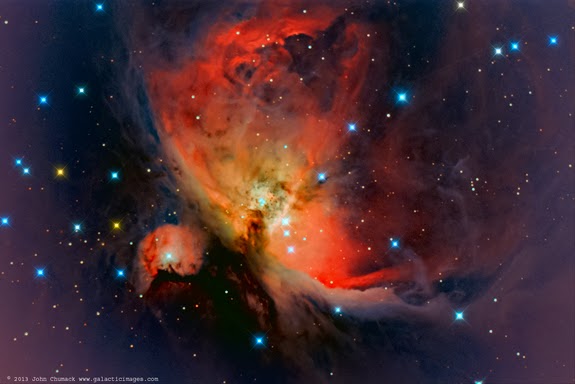Stargazer Snaps Beautiful Image of Massive Stellar Nursery
by Nina Sen SPACE.com | October 15, 2013 12:55pm ET
Astrophotographer John Chumack took this photo of the Orion Nebula, M42 (NGC 1976) and De Mairan's Nebula M43 on Sept. 22 from his observatories in Yellow Springs Research Station in Yellow Springs, Ohio. He used his homemade 16" diameter F4.5 Fork Mounted Newtonian Telescope and QHY8 cooled color CCD camera to capture the image.
Credit: John Chumack | www.galacticimages.com
Astrophotographer John Chumack was killing time while waiting for Comet ISON (a potentially spectacular comet making its closest approach to the sun in November and December) to rise when he captured this beautiful image of the Orion Nebula, M42 (NGC 1976) along with neighbor, De Mairan's Nebula M43.
"The Orion Nebula is such a fantastic object that I just can't resist capturing a new shot each season," Chumack told SPACE.com via email.
Chumack took the photo on Sept. 22 at his observatories in Yellow Springs Research Station in Yellow Springs, Ohio, over 40 minutes with his homemade 16" diameter F4.5 Fork Mounted Newtonian Telescope and QHY8 cooled color CCD camera.
Located approximately 1,500 light-years away, the Orion Nebula is the nearest region of massive star-formation to Earth. Located at the heart of the nebula is a group of gigantic, young stars; collectively called the "Trapezium" because of the shape they make.
Chumack took 62 separate various length exposures, ranging from one second to 300 seconds, after which he carefully layered the exposures to prevent over exposure of the Trapezium cluster. Also visible around the cluster are little brown specs called Bok Globules, which are newborn stars.
"The Constellation of Orion is rising higher in early morning sky and M42 is so bright and has such a high dynamic range that most shots over expose the Trapezium and nebula center," Chumack said.
Surrounding a single bright star, M43 is the little bubble-shaped area toward the lower left side of the image.
Officially catalogued as Messier 17 (M17) and NGC 6618, the nebula in this image is also called the Omega Nebula, the Swan Nebula, the Horseshoe Nebula and the Lobster Nebula. Former NASA scientist Fred Herrmann of Huntsville, Ala., sent this photo of the Omega Nebula to SPACE.com on Sept. 25, 2013. He used a Takahashi TOA-130 Telescope, STT-8300 Monochrome CCD Camera, and Ha and Oiii elemental filters to capture the image
Credit: Fred Herrmann | Owl Mountain Observatory


